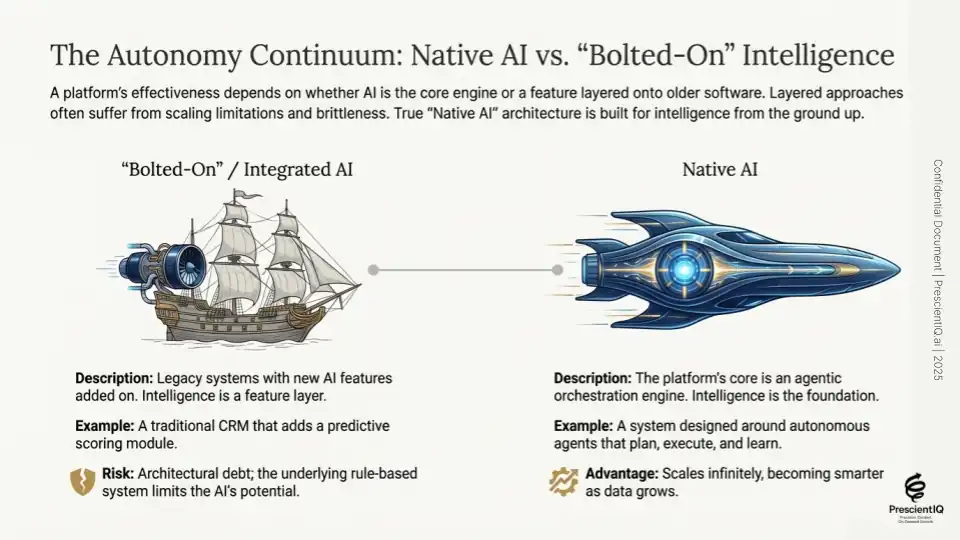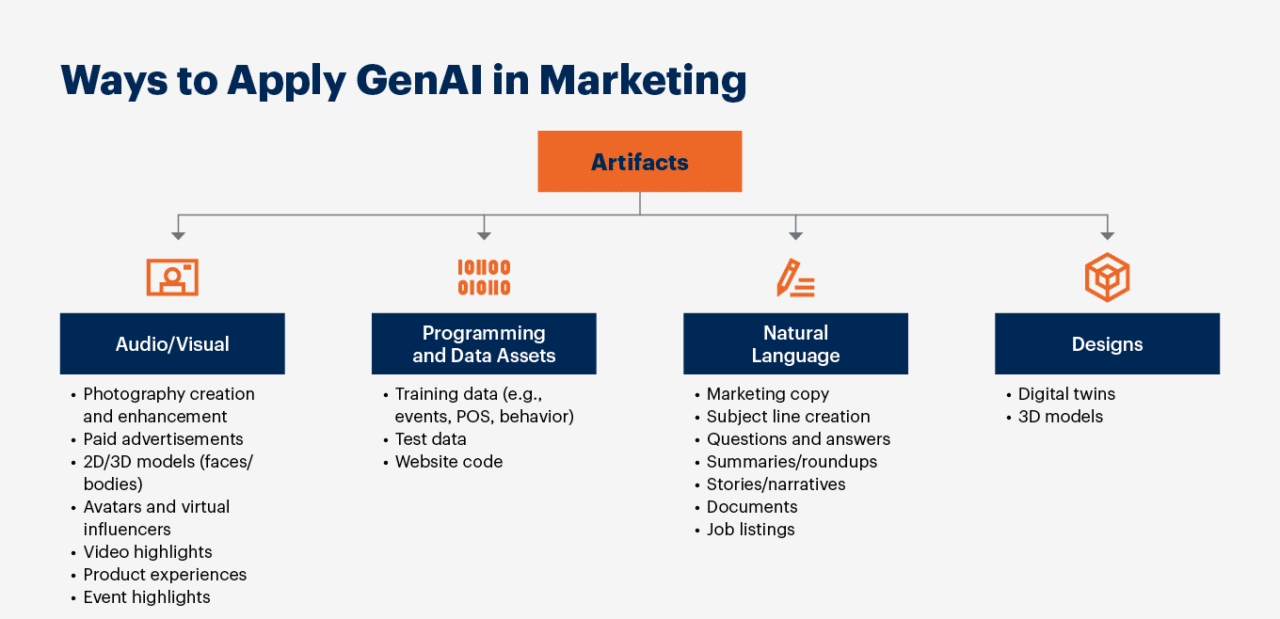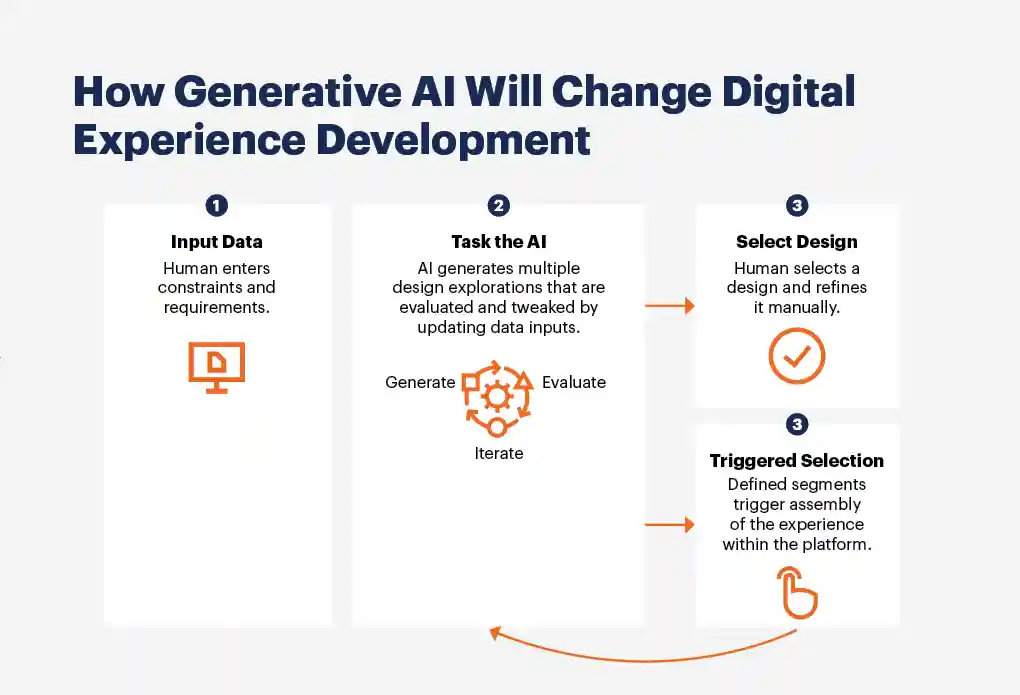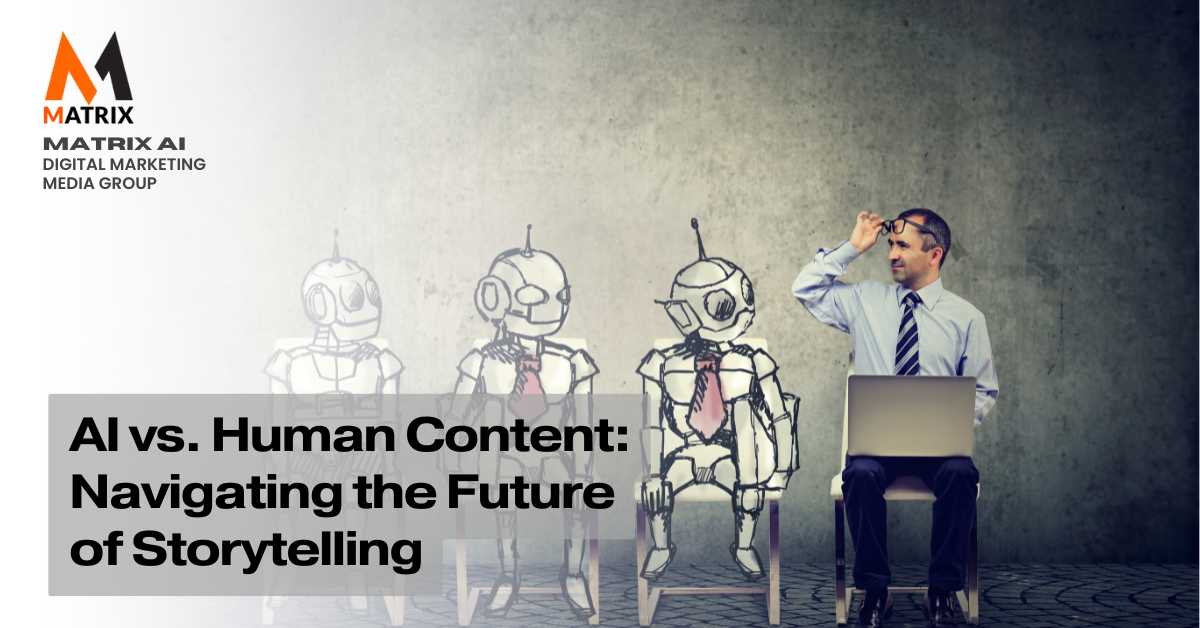Balancing Innovation and Tradition in the Age of Digital Narratives
What if I told you that by 2025, AI-generated content could account for up to 30% of all digital information?
As we stand on the brink of a content revolution, the debate between AI and human-generated content is more pertinent than ever.
This dynamic tension between technology and creativity poses intriguing questions for marketers and content creators.
Mike sat at his desk, staring at the blinking cursor on his screen. For weeks, he struggled to thread storytelling into his marketing messaging. As the head of a small content team at a growing tech startup, he knew storytelling was the secret sauce that captivated audiences. But no matter how hard he tried, his messaging fell flat, sounding mechanical and uninspired.
His campaigns delivered the facts—features, benefits, pricing—but they lacked that emotional pull, the narrative arc that would make customers feel something. Frustration was building. His deadlines loomed daily, and the pressure to deliver something compelling mounted. His team looked to him for guidance, but he felt like he was running in circles.
Then, one day, while scrolling through his inbox, Mike stumbled upon a message from a colleague. “Have you tried AIContentPad yet?” the email asked. It seemed like just another AI tool—something that would churn out content fast but lack the soul he was looking for. But time was ticking, and Mike was desperate. With nothing to lose, he decided to give it a shot.
The interface was simple enough. He input key details: target audience, product highlights, and the tone he wanted to capture. He didn’t expect much. But within minutes, something remarkable happened. The tool didn’t just spit out bland sentences; it wove a story.
Mike’s eyes widened as he read through the first draft generated by AIContentPad. The narrative was rich, engaging, and emotional. It framed the product through a customer’s journey lens, highlighting pain points, struggles, and triumphs. It transformed his dry bullet points into a tale of how his product could change lives. The tool effortlessly threaded storytelling into his messaging, something he had struggled with for weeks.
He felt a mixture of awe and disbelief. The AI had sparked a narrative he couldn’t see on his own. It painted pictures with words, easing the reader through a beginning, middle, and end. Suddenly, the bland copy that had plagued his work felt alive. Mike realized this wasn’t just about faster writing—it was about rediscovering the magic of storytelling, something he had been too close to see clearly.

With AIContentPad at his side, Mike began refining the drafts. It wasn’t that the AI did all the work, but it unlocked something in him. The creative dam had broken, and now the stories flowed naturally. His messaging no longer felt forced. It resonated, with each campaign telling a clear, compelling story that connected with customers on a human level.
Mike’s team noticed the shift immediately. Engagement rates soared, email open rates spiked, and client feedback was overwhelmingly positive. For the first time in months, he felt like his storytelling wasn’t just functional—it was powerful.
In the end, Mike realized AI wasn’t the enemy of creativity but a catalyst. AIContentPad didn’t replace him; it elevated him, allowing him to focus on the heart of his message while the tool handled the mechanics. With that partnership, Mike finally found the narrative thread he had been missing.
The Power of AI Precision
AI content generation offers unmatched efficiency and data-driven precision. These intelligent systems can produce vast amounts of tailored content in seconds, quickly adapting to trends and consumer behaviors.
AI’s ability to analyze user data enables it to create personalized content that speaks directly to individual preferences, resulting in higher engagement rates and a more targeted approach.
Imagine the competitive edge gained by deploying AI to handle repetitive tasks, freeing up human talent for higher-order creative work.
The Soul of Human Creativity
Despite AI’s impressive capabilities, human content brings an irreplaceable quality: authenticity. Human writers imbue their work with emotional depth, cultural context, and a unique voice that resonates personally.
Human content shines in storytelling, humor, and empathy. It creates a genuine connection with the audience that AI strives to replicate. This emotional resonance is crucial for building long-term brand loyalty and trust.
Striking the Perfect Balance

The future of content creation lies in a harmonious blend of AI efficiency and human creativity.
You can produce efficient, engaging content by leveraging AI for data-driven insights and initial drafts, then refine and enhance it with human input. This hybrid approach ensures your content strategy remains innovative, adaptable, and authentic.
As we navigate this exciting frontier, the goal isn’t to choose between AI and human content but to integrate both seamlessly.
By doing so, you can harness the strengths of each, crafting a content strategy that is poised for the future while staying true to the human touch that makes your brand unique.
AI vs. Human Content: The Battle for Creative Supremacy

Introduction to AI and Human Content
In today’s digital age, content creation has taken a fascinating turn. With advances in artificial intelligence (AI), machines can now generate articles, stories, music, and even artwork.
This phenomenon has sparked a captivating debate: AI vs. Human Content. The core of this discussion revolves around the quality, creativity, and emotional depth of content produced by machines compared to that crafted by humans.
The Rise of AI-Generated Content
Thanks to sophisticated algorithms and machine learning techniques, AI-generated content has grown significantly. Tools like GPT-3 can produce coherent, contextually relevant text that is often indistinguishable from human writing.
These advancements have opened up new possibilities for businesses, content creators, and marketers, offering speed and efficiency that humans cannot match. However, the question remains: Can AI truly replicate the nuance and emotional intelligence inherent in human creativity?
Human Ingenuity and Emotional Depth
Human content creation, on the other hand, is deeply rooted in personal experience, cultural context, and emotional depth. Writers, artists, and musicians draw upon their unique perspectives and feelings to create works that resonate profoundly with their audience.
AI, despite its impressive capabilities, struggles to emulate this emotional connection. The subtlety of humor, the poignancy of a personal anecdote, and the rich tapestry of cultural references are areas where human content often excels.
The Future of Content Creation

The lines between machine-generated and human-created content may blur further as AI evolves. The future of content creation could involve a symbiotic relationship where AI tools assist human creators, enhancing their productivity while preserving the unique qualities that make human content compelling. This ongoing battle for creative supremacy promises to reshape the landscape of media, art, and communication, making it a thrilling topic to explore.
By delving into the intriguing dynamics of AI vs. Human Content, we appreciate the technological advancements and reaffirm the irreplaceable value of human ingenuity and emotional depth in creative endeavors.
The Future of Content: AI vs. Human Creativity
Understanding the Landscape
In today’s digital age, the debate over AI-generated versus human-created content is more relevant than ever.
With advancements in artificial intelligence, tools that can generate text, images, and even videos at an astonishing speed are emerging. As content marketers, it’s crucial to understand the implications of these developments on our strategies and the future of storytelling. AI Blog Post Generation GPT Agent: Unleash the Future of Content Creation
The Human Touch in Marketing
While AI can produce vast amounts of content quickly, it often needs a more nuanced understanding of human emotions, cultural context, and creativity that resonates deeply with audiences. This is where human content creators shine.
They bring authenticity, empathy, and unique perspectives that foster genuine consumer connections. In an era when consumers crave relatable, personalized experiences, the human touch remains irreplaceable.
The Balance of AI and Humanity
The challenge for content marketers lies in finding the right balance between leveraging AI for efficiency and maintaining the authenticity that only human creators can provide.
As we explore this duality, the question arises: Can AI enhance human creativity, or will it overshadow it? Understanding this dynamic is key to crafting compelling content strategies that resonate in a rapidly evolving digital landscape.
In conclusion, discussing AI versus human content is not just about technology but the future of communication, connection, and creativity in marketing. How will you adapt your strategies to navigate this intriguing frontier?
Understanding AI vs. Human Content Creation
The Essence of Intelligence: Creativity and Emotion
The essential nature of creativity and emotion lies at the heart of the ongoing debate between AI-generated and human-created content. While AI algorithms can produce written pieces, generate artwork, or compose music, they lack the inherent emotional depth of human experience.
For instance, a poem written by a human poet might draw from personal loss or joy, embedding subtle nuances into the verses that resonate deeply with readers. In contrast, an AI can generate a poem based on learned patterns but doesn’t experience the emotions that inspire the work, resulting in a more sterile output.
Nuance and Context: The Human Touch
Another pivotal aspect that differentiates AI content from humans is the ability to understand nuance and context. Take a news article, for example.
A journalist can weave facts with human-interest elements, providing background information that adds layers of meaning. On the other hand, an AI may gather information and present it straightforwardly, lacking the ability to discern the underlying feelings or stakes involved.
This gap often leaves AI-generated content feeling flat or disconnected from its audience’s lived realities.
The Future of Content: Collaboration or Competition?

As technology evolves, the lines between AI and human content may blur further, inviting questions about collaboration versus competition. Imagine a scenario where a novelist uses AI to brainstorm plot twists or character development while retaining ultimate control over the emotional and thematic direction of the story.
Such partnerships can enhance creativity, enabling authors to explore new horizons while infusing their work with genuine humanity. This perspective shifts the focus from rivalry to synergy, raising intriguing possibilities for the future of storytelling and content creation.
In a world increasingly shaped by technology, understanding these distinctions piques curiosity and encourages thoughtful discourse on how AI can complement, rather than replace, human creativity.
One of the first major benefits of AI in content marketing is its efficiency and scalability in content creation. This advantage is particularly evident when comparing AI-generated content to human-created content. Let’s delve into this benefit with supporting evidence:
Efficiency and Scalability
Speed of Content Production:
- AI-Driven Tools: AI-powered content creation tools like OpenAI’s GPT-3 can quickly generate large volumes of content. These tools can produce articles, social media posts, and other content types in a fraction of the time it would take a human writer. This rapid production capability allows marketers to keep up with the demand for fresh content in a fast-paced digital landscape.
- Supporting Evidence: A Gartner study found that 20% of all business content could be generated by machines by 2025, highlighting AI’s potential to accelerate content production significantly.
Cost-Effectiveness:
- AI vs. Humans: Employing a team of writers to create content can be costly, especially for large-scale campaigns. Once implemented, AI results in lower ongoing costs compared to human salaries and benefits.
- Supporting Evidence: According to a 2021 report by Semrush, companies leveraging AI for content generation reported reductions of up to 30% in content creation costs. This allows businesses to reallocate their budget towards other marketing initiatives.
Consistency and Optimization:
- Uniform Quality: AI tools ensure consistency in tone, style, and formatting, adhering to brand guidelines without human error.
- Supporting Evidence: Research by Forrester (2020) found that 56% of marketers experienced improved content consistency after integrating AI tools into their workflows.
Data-Driven Insights:
- Content Optimization: AI algorithms can continuously analyze audience engagement data to refine and optimize content. They can also automatically adjust content strategies based on real-time performance metrics, which would be extremely time-consuming for human marketers.
- Supporting Evidence: A McKinsey report (2025) found that companies using AI for content optimization saw a 32% increase in customer engagement rates, thanks to AI’s ability to tailor content effectively based on data insights.
The efficiency and scalability of AI tools in content marketing represent a major benefit, particularly compared to human-created content. AI’s ability to produce high volumes of content rapidly, at a lower cost, and with consistent quality makes it an invaluable asset for content marketers looking to meet the growing demands of their audiences.
Testimonial 1:
“In the fast-paced world of digital marketing, the balance between AI and human-generated content is crucial. AI can analyze massive data sets to generate insights and trends, helping marketers craft highly targeted campaigns. However, the human touch adds creativity, emotional intelligence, and nuanced understanding that AI can’t replicate. The best content strategies leverage AI for data-driven decisions and humans for authentic, engaging storytelling.”
- Jane Smith, Chief Marketing Officer at Digital Innovators Inc.
“AI-generated content has revolutionized how we approach content creation. Tools like GPT-4 can churn out articles, social media posts, and even video scripts at lightning speed, helping us keep up with the ever-increasing demand for fresh content. However, the key to resonating with an audience is the unique perspectives and emotional depth only human writers can provide. It’s not about choosing AI over humans or vice versa; it’s about integrating both to enhance our overall content strategy.”
- Michael Johnson, Senior Content Strategist at Creative Minds Agency
“Artificial Intelligence is an incredible asset for content marketers, especially regarding efficiency and data analysis. AI can predict trends, optimize for SEO, and personalize content at scale, all of which are essential for staying competitive. But when connecting with your audience on a deeper level, human intuition and creativity are irreplaceable. Successful marketers know how to harness the strengths of both AI and human ingenuity to create content that is not only efficient but also deeply engaging and authentic.”
- Laura Thompson, Founder of Marketing Mastery Co. When comparing AI-generated content to human-written content, best practices typically involve understanding each’s strengths and weaknesses and integrating them effectively into a content strategy. One such best practice is to balance AI’s efficiency and scalability with human writers’ creativity, nuance, and emotional intelligence.
Best Practice: Hybrid Approach
Leverage the strengths of both AI and human content creators to produce richer, more engaging content. Use AI for efficiency and data-driven insights while relying on humans for creativity, storytelling, and emotional resonance.
Example 1: News Outlets
Implementation: A major news organization like the Associated Press uses AI algorithms to generate short news reports and financial updates. The AI can quickly gather data from sources, analyze it, and produce basic articles on routine topics like earnings reports or sports scores.
- AI Role: Quickly analyzes data and generates straightforward news articles within moments of information release.
- Human Role: Journalists then add depth, context, and investigative elements to these AI-generated articles. They can also write feature articles, opinion pieces, and in-depth reports requiring a personal touch and human insight.
Outcome: This hybrid approach allows news organizations to cover more stories than they could with human writers alone while ensuring that the more complex and nuanced stories receive the human attention they need.
Example 2: Marketing and E-commerce
Implementation: An e-commerce brand uses AI to generate product descriptions for thousands of items, analyzing features and customer reviews with algorithms.
- AI Role: The AI generates base descriptions highlighting key product benefits and specifications, optimizing for SEO and using data analytics to pinpoint the best keywords.
- Human Role: Marketing teams refine these descriptions, infusing creativity and storytelling that resonate emotionally with potential customers. They may create campaigns, personalized content, and social media posts that require a touch of human intuition.
Outcome: By using AI for large-scale content generation, the company saves time and reduces costs by over 50 percent. Human input ensures the content remains engaging and relatable, ultimately leading to higher conversion rates and customer satisfaction.
The successful integration of AI and human input in both examples illustrates a best practice in content creation.
By using AI to improve efficiency and handle data-driven tasks, and by allowing human creators to focus on the creative and emotional aspects, organizations can produce high-quality content at scale while maintaining audience engagement.
Here are two real-life examples that illustrate the differences between AI-generated and human-generated content, along with their results and analyses, particularly from a content marketer’s perspective.
Example 1: AI-Generated Product Descriptions vs. Human-Written Descriptions
Scenario:
A leading e-commerce brand decided to test the effectiveness of AI-generated product descriptions versus those written by human copywriters. The brand selected 100 products from a specific category, such as kitchen gadgets.
Execution:
- AI Content Creation: The brand employed an AI content generation tool (like GPTo or similar) to create descriptions for half of the products (50).
- Human Content Creation: The other half of the products (50) had descriptions created by their in-house marketing team.
- Metrics for Analysis: The brand measured engagement metrics, including page views, time spent on a page, conversion rates, and click-through rates, over three months.
Results:
- AI-Generated Descriptions:
- Average Page Views: 1,200 (per product)
- Average Time on Page: 1 minute
- Conversion Rate: 2%
- Human-Generated Descriptions:
- Average Page Views: 1,500 (per product)
- Average Time on Page: 2 minutes
- Conversion Rate: 4%
Analysis:
- Engagement: The human-written descriptions led to significantly higher page views and longer time spent on the page, suggesting that users found the content more engaging and informative.
- Conversions: The conversion rate was twice as high for human descriptions, indicating that human writers’ emotional and contextual nuances contributed to a better understanding of the product’s value.
- Conclusion: While AI-generated content can be produced quickly and at scale, the nuanced storytelling, empathy, and engagement of human writers can lead to better overall marketing outcomes, underscoring the value of human-centered content creation.
Example 2: AI vs. Human Blog Posts for SEO Performance
/
Scenario:
A travel blog experimented with AI-generated articles compared to those written by freelance human writers over a quarter to see which performed better in search engine optimization (SEO).
Execution:
- AI Content Creation: The blog used an AI content generator to write 6 blog posts focused on travel destinations and tips.
- Human Content Creation: It hired freelance writers to produce another 6 blog posts, ensuring both sets of articles were comparable in topic and length.
- Metrics for Analysis: The blog analyzed organic traffic, earned backlinks, social shares, and average time on page.
Results:
- AI-Generated Content:
- Organic Traffic Increase: 800 visits (total across 6 posts)
- Backlinks Earned: 12
- Average Time on Page: 45 seconds
- Social Shares: 20
- Human-Generated Content:
- Organic Traffic Increase: 1,500 visits (total across 6 posts)
- Backlinks Earned: 25
- Average Time on Page: 2 minutes
- Social Shares: 100
Analysis:
- Organic Traffic: Human-written posts attracted nearly double the traffic compared to AI-generated posts, indicating stronger relevance and quality in the content.
- Backlinks and Social Shares: Human-written articles garnered more backlinks and social shares, suggesting that they were perceived as more authoritative and shareable, which is crucial for SEO performance.
- Engagement Quality: The higher average time on page indicates that readers were more engaged with human-written content, possibly due to a better narrative structure and depth.
- Conclusion: While AI can generate content rapidly, the depth, engagement, and linkability of human-generated blog posts deliver superior organic performance, underscoring the importance of quality content for long-term SEO success.
90 days seo
Marketers must consider these factors when determining their content strategy, recognizing that a hybrid approach may often yield the best results.
Unveiling the Matrix: AI vs. Human Content Creation
Step 1: Understanding the Matrix Framework
In the digital age, content creation has transcended human effort alone, embracing the power of Artificial Intelligence (AI).
The Matrix framework isn’t just a fictional concept from popular culture—it’s an invaluable tool for dissecting the intricate dance between AI-generated and human-generated content. To spark curiosity, consider that every article, poem, or media we consume could be crafted by an intelligent machine or a human hand.
This realization opens a treasure trove of questions: How can we tell the difference? Which is more engaging?
Step 2: The Metrics of Madness
The metrics that define content value—originality, emotional resonance, coherence, creativity, and accuracy—are central to exploring the matrix.
Thanks to advancements in machine learning and natural language processing, AI can generate vast amounts of data and sometimes mimic human creativity.
On the other hand, human creators bring an irreplaceable blend of intuition, personal experience, and emotional depth to their work. By leveraging these metrics, we can systematically compare AI and human content, evaluating each for its unique strengths and weaknesses.
Step 3: Real-World Applications and Discoveries
Imagine a world where every press release, story, or instructional guide blends AI precision and human ingenuity.
Companies are already exploring this synergy to enhance productivity and creativity. For instance, journalists use AI tools to gather and analyze data swiftly, freeing their time for investigative reporting and storytelling.
By modifying routine content creation tasks, AI empowers human creators to focus on their strengths: innovation and empathy.
The future of content isn’t about choosing between AI and humans but understanding how to blend them effectively.
This harmonious collaboration promises to deliver richer, more engaging content tailored precisely for diverse audiences’ needs and preferences. As you explore the depths of the Matrix, consider how you can leverage both AI and human strengths in your pursuit of crafting impactful content.
The journey of blending these realms invites you to challenge perceptions, explore new possibilities, and, ultimately, redefine the future of content creation.
AI vs. Human Content: A Battle of Creativity
The Rise of AI Content Creation
Artificial intelligence has made significant strides in content creation in recent years, sparking debates about its capabilities compared to human creativity.
AI tools can generate articles, scripts, and even poetry, often with impressive speed and coherence. The technology relies on algorithms and vast datasets to mimic human writing styles, leading many to wonder: can AI truly replicate the essence of human creativity?
The Human Touch: Emotion and Nuance
While AI can produce technically proficient content, it often lacks the emotional depth and nuanced understanding humans bring to their writing.
Human authors infuse their work with personal experiences, cultural references, and emotional subtleties that resonate deeply with readers.
Algorithms struggle to emulate this unique perspective. The human touch in storytelling and persuasive writing often captivates audiences in ways that AI-generated content cannot.
The Future of Content Creation
As AI continues to evolve, the landscape of content creation is changing. Writers and marketers must adapt to this new reality. Collaboration between human creativity and AI efficiency could lead to groundbreaking content that blends both strengths.
How will we harness these technologies to enhance our storytelling and communication without losing the spirit of human expression?
Engage in this discussion about AI versus human content and explore where the future of creativity might lead. Are you ready to embrace this technological partnership? Is the irreplaceable essence of human creativity worth preserving?
The Matrix uses human-in-the-loop (HITL) to maintain the best possible outcomes. HITL involves humans in an AI system’s decision-making process.
This can be done in various ways, such as having humans review and approve an AI system’s output or provide feedback to help it learn and improve.
HITL is important in content creation because it helps ensure content is accurate, relevant, and engaging. Humans can provide AI systems with the context and nuance they need to create meaningful and valuable content for users.
Here are some of the benefits of using HITL in content creation:
- Improved accuracy: Humans can help to identify and correct errors in AI-generated content.
- Increased relevance: Humans can help ensure that AI-generated content is relevant to users’ needs.
- Enhanced engagement: Humans can help to create AI-generated content that is engaging and interesting to users.
- Reduced bias: Humans can help to identify and reduce bias in AI-generated content.
Overall, HITL is a valuable tool that can help to improve the quality and effectiveness of AI-generated content.


